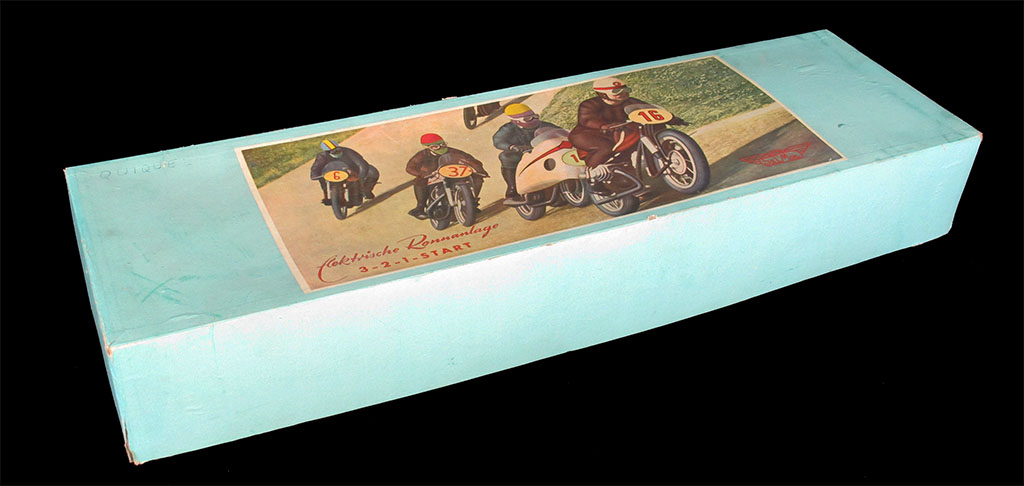
3-2-1 START
Selmac, Spain,
1950s

When I first posted this game in 2017, I had more questions than answers. This is how I introduced the game:
This is a mechanical game made by Sel-Mac in Barcelona. Some things about this game are obviously strange. First of all there is the title of the game in English and the subtitle "Elektrische Rennanlage" ("electric racing system") in German. One has to understand that nobody spoke English (much less German) in Spain when this game was made. We can think that the game was made to export, but the only copies I have ever seen are in Spain, so it does not look like it sold much abroad.
The second obvious weirdness is the motorcycles featured in the box, while in the game you find cyclists, cars, and horse, but no motorcycles.
Finally, the game was packed in boxes of different colours. In this case, the box is light blue, as you can, see, but there were more colours.
Eight years later, Siegfried L. has carried a thorough investigation about this game. His work is so good that I include it (mostly) untouched at the bottom of this review. By the way, Siegfried also clarifies that both the subtitle and the title of the game are in German, since there is no German word for "Start" in racing and, as many other sports words (im many languages, I would add), it is simply taken from English.

Beware, this game works with 110/125 V.
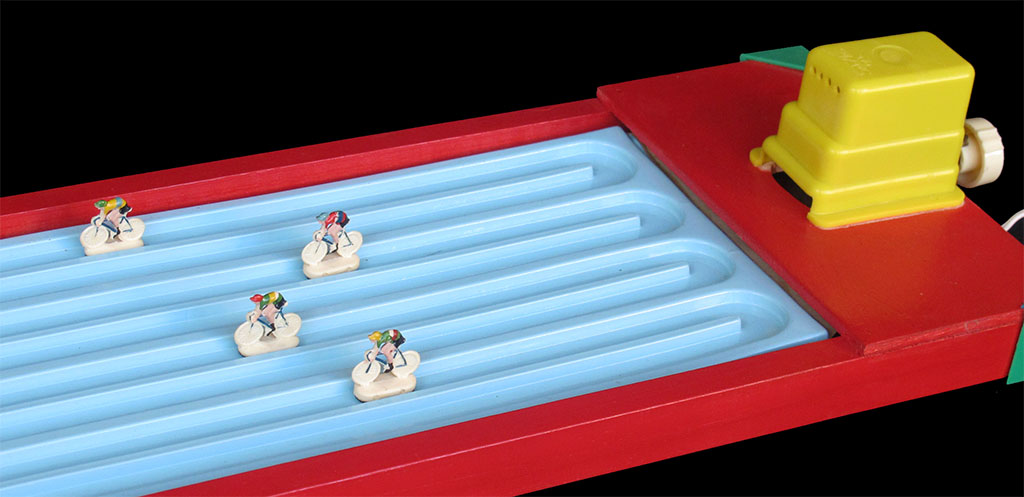
The game consists of 4 oval tracks wich vibrate. The cyclists (or cars, or horses) are unevenly weighted so that they always advance, no matter in what part of the vibrating track you place them.
Siegfried L. suggests the following explanation:
The game consists of 4 oval tracks which vibrate. The cyclists (or cars, or horses) are unevenly weighted so that they always advance, no matter in what part of the vibrating track you place them. I'm sure, the "secret" that drives the cyclists/cars/horses forward is the "fur" at the underside of their base. The vibrating track moves equally towards all possible directions. This movement causes corresponding forces onto the cyclists/cars/horses. As their friction coefficient is lower when moving forwards and higher when moving backwards (because of the fur) and as they cannot move sideways, the sum of all applied, variing forces always will move the cyclists/cars/ horses more forwards than backwards.
That's why the first paragraph of the instructions advices that the underside of the cyclists/cars/horses and the track have to be kept clean. (*) Dirty cyclists probably will be slower, a dirty track probably could make them faster.You can check my friction theory by a simple experiment: Cover the fur on the underside of a cyclist with an adhesive tape (probably it's better to protect the fur by a piece of paper). In this setup the cyclist is still unevenly weighted, the only difference is the friction coefficient, that now is equal in all directions. I'm sure, in this setup the cyclist won't move – or will move much slower, maybe he could move even backwards if he's unevenly weighted in the wrong direction. (**)
(*) I do not have that part.
(**) I haven't tried yet, I will let you know when I do.
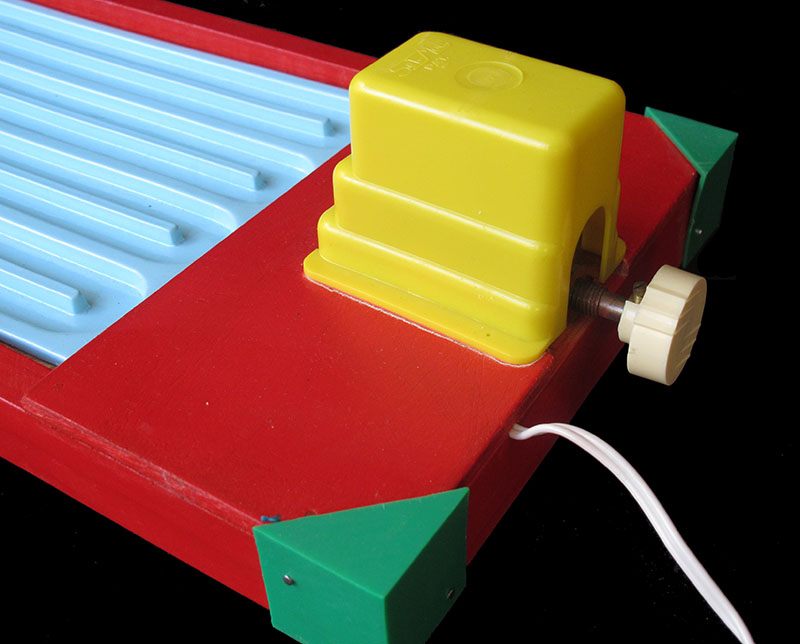
You can control the vibration, so that the board vibrates more when the riders are in the straights and less when they are in the curves. This way the riders are faster on the straights, but they do not fall off the track when they arrive to the bends. Of course, this is the correct strategy a long as there is only one cyclist/car/horse on the track.
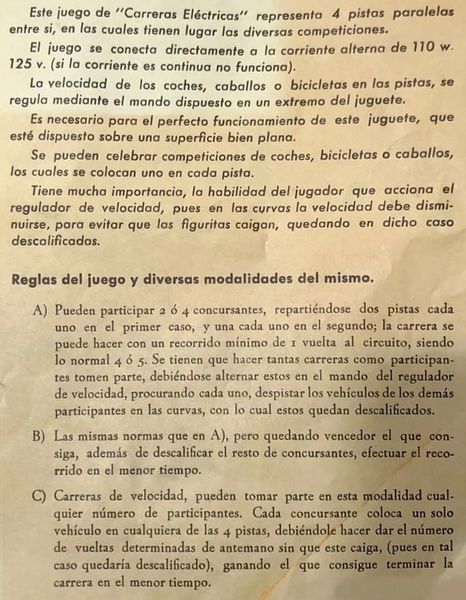
UPDATE 2025: In 2017 I added: "Unfortunately I do not have a copy of the rules to check if time trials are mentioned". I do have the rules now, and they do not mention time trials. What they do mention is that the player controlling the vibration will try to make the other players fall. Nasty!

While the box is quite big, the cyclists, obviously, are not.
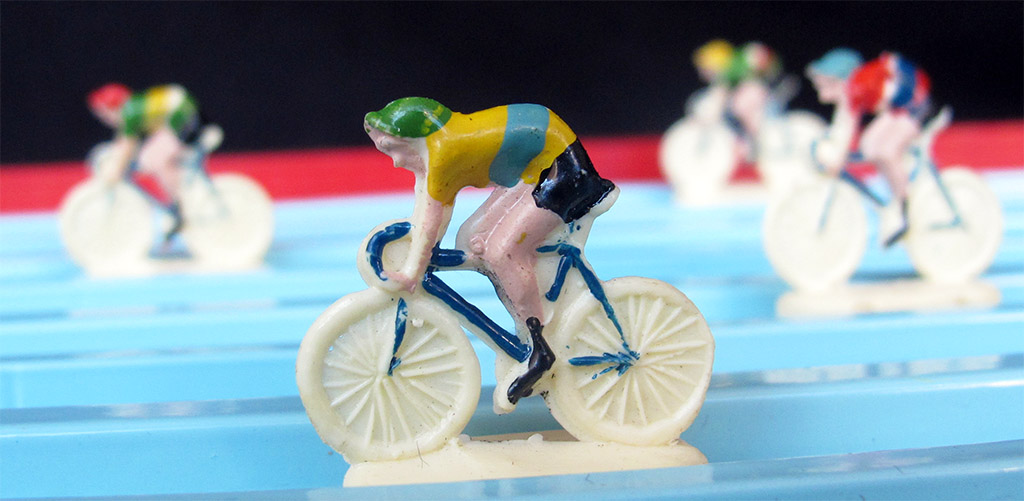
They measure just 24 mm.
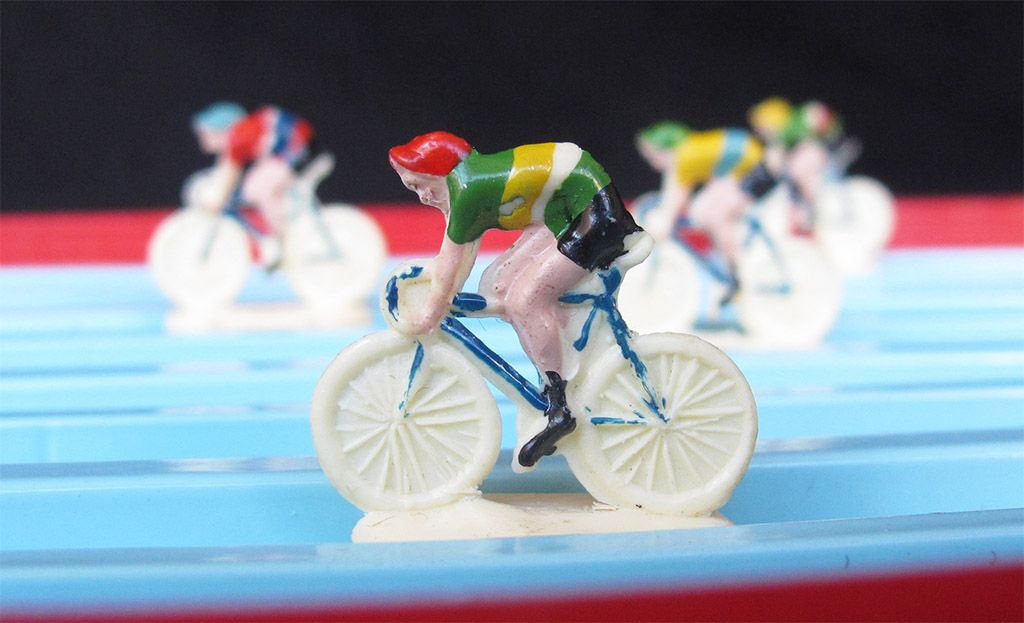
They are made of a hard plastic, maybe bakelite, and are hand-painted.
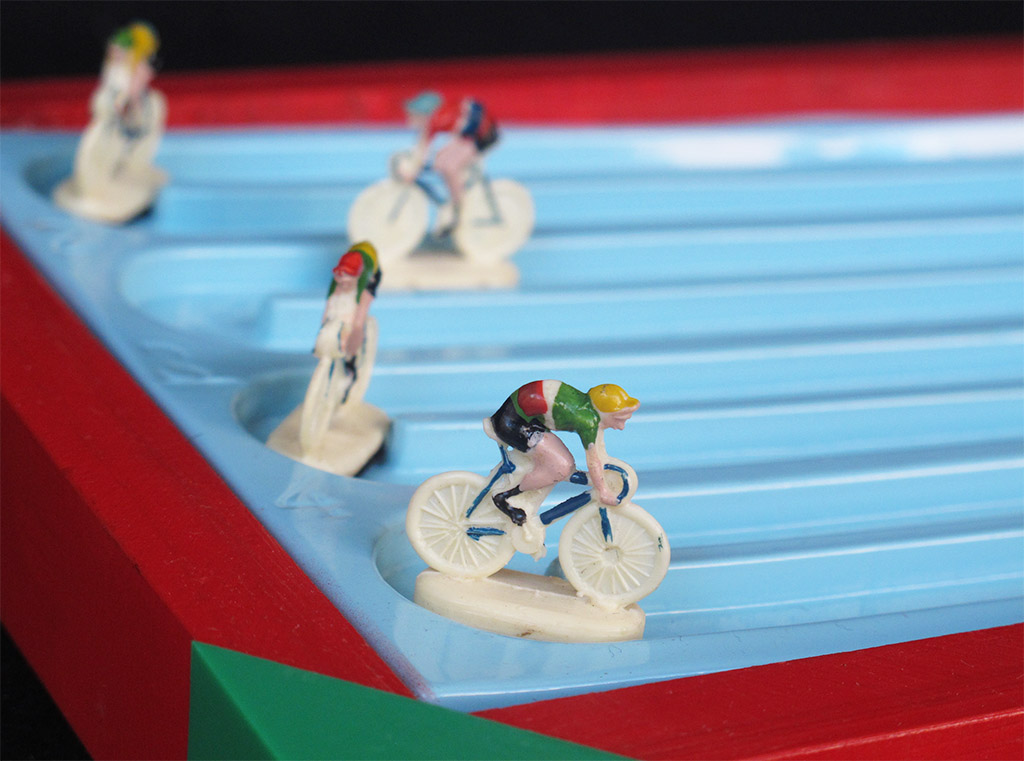
Going around the bend, the most dangerous part of the course...
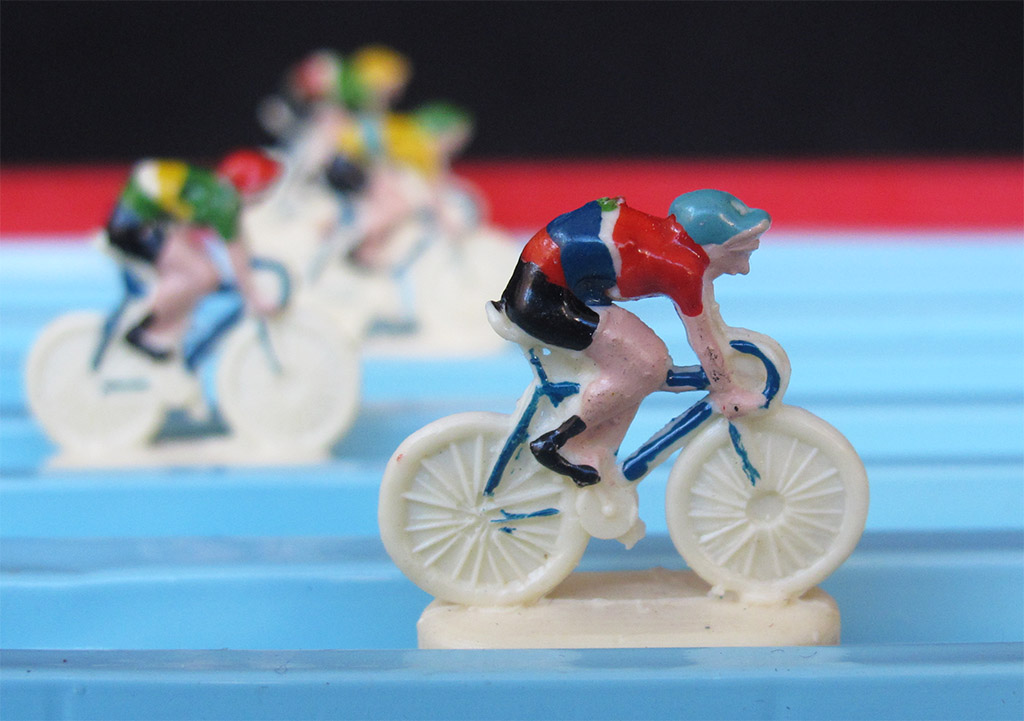
...and sprinting back.
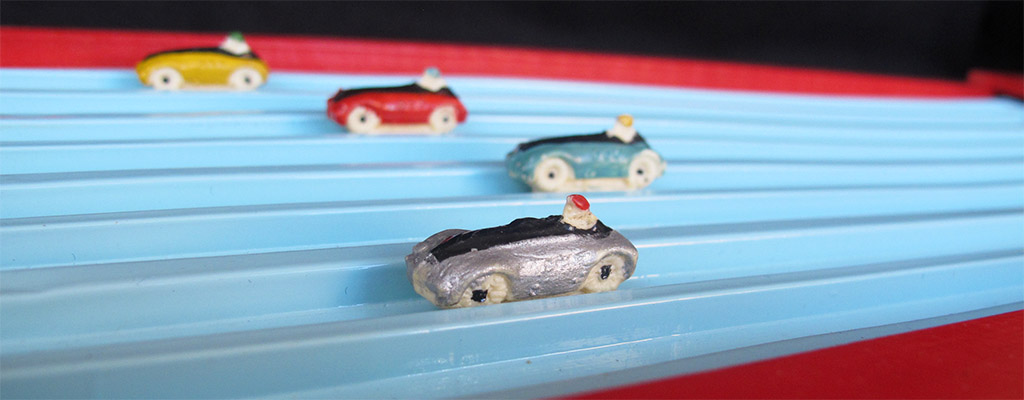
Nice cars, though poorly painted.
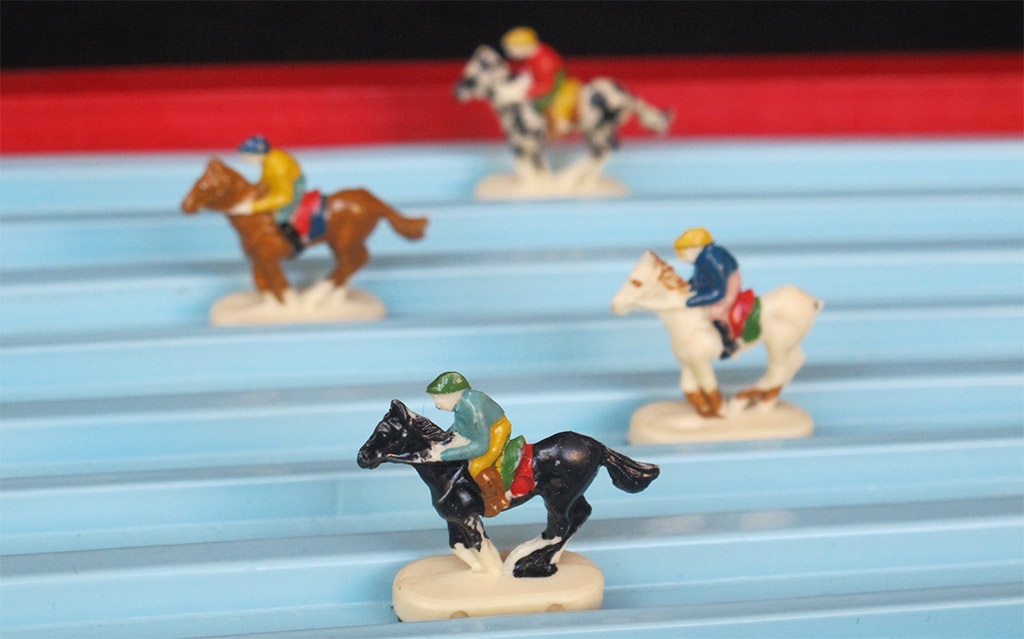
On the other hand, horses are well painted. (My white horse has lost its tail, though)
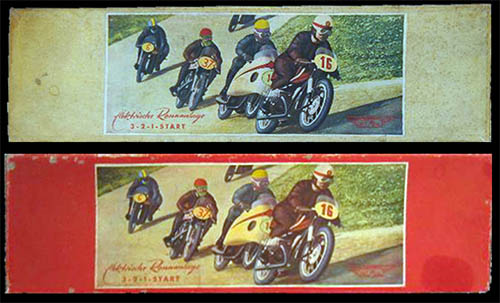
Boxes of different colours. These boxes, by the way, are quite big: they measure 70 x 21 x 10 cms.
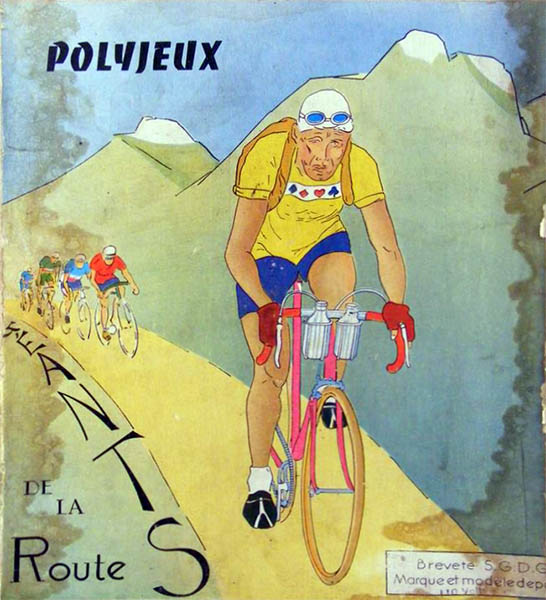
The game was also issued in France, by Polyjeux. It was called "Les Géants de la Route but, despite its unmistakably cycling-related name, it also included cars and horses. (Thanks, Marc, for the clarification).
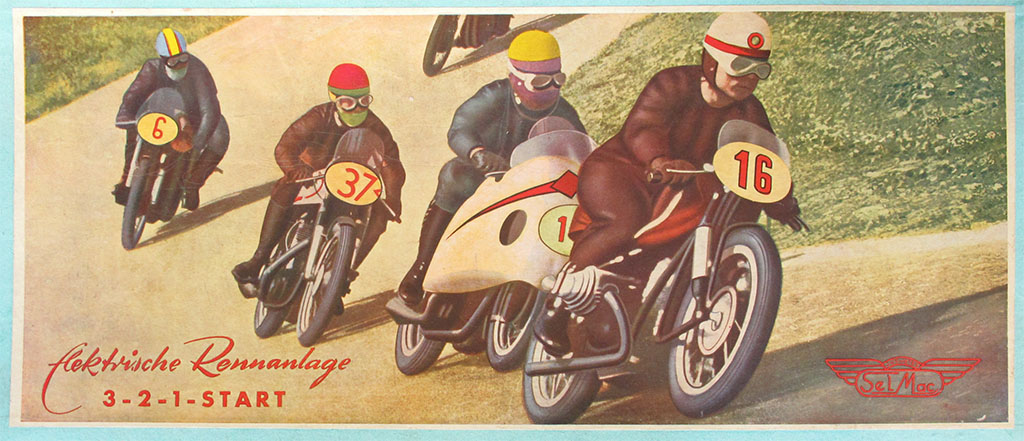
Nice illustration... but why motorbikes???
Well, Siegfried L. has provided the answer (and much more):
Althought today I'm neither a motorcycle rider nor a motorcycle fan, many years ago I watched some historic motorcycle races. Therefore what caught my eyes in this game was the picture of the racing motorcycles. The leading rider is on a German motorcycle. Just because of this picture and the German title I already thought, this initially must have been a German game. Of course I wanted to find out which other motorcycles are pictured here.
The machine in front (number 16) is a BMW RS 54 with its characteristic "pushed swing rod" at the front wheel, that works like a mirrored rear suspension (the joint of the pushed rod is visible in the photo, but not in the painting). This motorcycle of course had the 2-cylinder boxer engine typical for BMW, with a capacity of 500 cc, but specially designed cylinder heads (which can be identified in the painting). The RS 54 was a pure racing machine, intended for racing only, it was built from 1954 to 1956 (I mirrored the left image below to enable a better comparison with the painting).
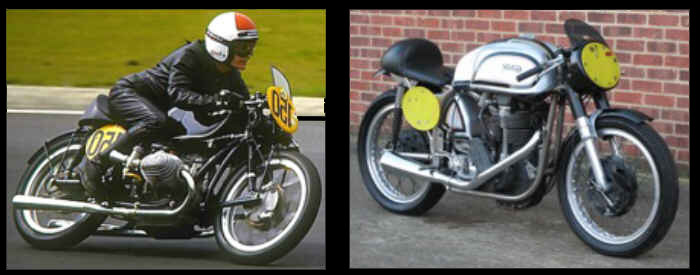
The third motorcycle (number 37) is a Norton Manx 500 (one cylinder, DOHC), one of the most popular and successful racing machines ever, built from 1950 to 1962. In the starting list of the 1956 German Grand Prix 19 of 37 machines in the 500 cc class were Nortons. Even 6 of the 12 German riders preferred Norton. In the 1950s Norton motorcycles were present in almost every race. I can understand why Norton was so popular – just look at this straight-designed, well-proportioned beauty! And she also was both quite fast and reliable.The second machine is another Norton (compare the characteristic frame tubes and the exhaust pipe), it's only equipped with an aero cover. I found no picture of exactly the same cover, but the left picture below (a 350 cc Norton) isn't far away. The right picture below would come closer. It is a DKW RM 350 (nick-named "the singing saw" because of its sound, the 3 cyclinder two-stroke engine ran at up to incredible 15.000 revs). In the mid 1950s many different aero covers were used, aero testing was done by "trial and error" in the races. When some years later the aero design options were limited because race accidents had increased, most aero covers became scrap metal, so only few original parts survived.

The fourth machine (number 6) in the game's picture could be another Norton or a Matchless. AMC, the company who owned Matchless, bought Norton in 1953 and its new "sister" Matchless seems to have gained a transfer of technology. In the late 1950s the Matchless 500 cc single cylinder bikes looked quite similar to the Norton Manx.
Conclusion: The racing scene pictured in the game's box should be from the mid or late 1950s.
Of course the game was produced in Spain, but obviously the picture, because of the title, should be from Germany. Why did Sel-Mac put a presumably German picture on the box of this game? I had no clue to answer this question until a row of fortunate coincidences helped to solve the riddle... I assume this game was produced by an international cooperation, formed by Sel-Mac from Spain and a company named "Fibro" from Reichenbach/Fils, Germany. Fibro probably stands for Fischer and Brobeck, the presumable founders of this company. I'm not sure when it was founded and if toys were their only products, but I will try to find out more. Today there is a Fibro mechanical engineering company in Weinsberg, founded in 1958. I assume, the Weinsberg company could be a successor to the toy maker. Fibro produced the "3-2-1-Start" game too, and at one point of time they offered three different versions with the same game mechanics:
1. "Hinein in die Kurven" ("Into the bends") is the simplest and cheapest version, it has the same race course as your version, but only 3 cars, 3 horses and 3 cyclists. This would support the idea, this toy initially wasn't intended to simulate a race, as in this version one has different figurines running at the same time when all four lanes should be used.
2. "3-2-1-Start" has the same race track with four lanes, but 4 cars, 4 horses and 4 cyclists, as in the Sel-Mac version. It's different from the Sel-Mac version only in having a pit lane building that hides the motor, the building has a "Start u. Ziel" ("start and finish") sign on the roof.

3. "Start zum Großen Preis" ("Start of the Grand Prix") is the most advanced and sophisticated version of this racing toy. This one only has two separated wider tracks, and each track has its own control! So two players can compete in a real race. This version has bigger cars, a fuel station instead of the pit lane building – and can be considered to be a racing "game of skill".
You can find a description of these versions in the small, nicely illustrated Fibro catalogue. The cars at the "Start zum Großen Preis" are Mercedes-Benz 190 SL, in production from 1955 to 1963. There also is a Auto-Roulette game ("Achtung!!! Verkehrszeichen"), with a Porsche 356, which was slowly replaced by the Porsche 911 from 1965 on. So these cars also fit well into the mid 1950s, although there is no date written in the Fibro catalogue.
About what is the title and what is the subtitle of the games: Because of the three versions, at least for the German game it's the other way round: "Elektrische Rennanlage" is the (trivial) title of the game and "3-2-1-Start" only is the subtitle (of the 2nd game), to differentiate it from its sister-product "Hinein in die Kurven" (1st). The 3rd game according to the catalog has a different title, it's a "Elektrisches Auto-Rennspiel" ("electric car racing game") and its subtitle is "Start zum Großen Preis". Of course that's only logical for the German games. As Sel-Mac only has one version, you're free to choose what's the title and what's the subtitle. [I am not sure I agree on that: I still think that the name of the game is "3-2-1 Start"]
Most toys in the Fibro catalogue are described as "patend pending in Germany and abroad" (except the fishing game). I found no Sel-Mac catalogue on the www, there is only a little information taken from the book "Historia del ‘Soldadito de Plástico‘ Español" (page 467). According to this book, Sel-Mac produced two vibration games that also are in the Fibro catalogue ("3-2-1-Start" and a fishing game). But in the Fibro catalogue there are three other vibration games that Sel-Mac didn't produce ("Hinein in die Kurven" and "3-2-1-Start" only counted as one game).Therefore I'm sure Fibro invented the vibration games, at least that's much more likely. Why should Sel-Mac, if they were the inventors of all five games, produce only two of them and give the rights to produce the most advanced game ("Start zum Großen Preis") to a German company? The Barcelona company, founded in 1955, might have been the holder of a Spanish patent, although there is nothing written on the box or in the rules (on the other hand, the French version "Geants de la Route" states, Polyjeux was the owner of a French patent).
I'd assume, Fibro had some kind of cooperation with the Spanish and French companies. Maybe Fibro produced the basic mechanic and Sel-Mac supplied the plastic parts for the games? They seem to have had some expertise in this. Maybe as part of this cooperation Sel-Mac was allowed them to produce the "3-2-1-Start" game in a simpler version for the Spanish market, but Fibro kept the rights for the advanced racing game "Start zum Großen Preis" and the hunting games?
What is sure: As the Fibro catalogue shows many versions of electro-mechanical toys, to me it's logical that the creator of those games was Fibro. Only a Sel-Mac catalogue could prove the opposite (and prove the book "Historia del ‘Soldadito de Plástico‘ Español" to be wrong).
At first I thought there could be another possibility: Maybe Fibro produced these games only for a short time. As in 1958 a new Fibro mechanical engineering company was founded in Weinsberg, maybe Fibro stopped making toys, closed down the site in Reichenbach/Fils in 1958 and sold their rights for the vibration games – and remaining parts – to Sel-Mac, who started producing two of the five games? [..] To answer this question, the first Sel-Mac catalogue showing the vibration games would be helpful, too. However, one thing doesn't fit to my assumption: The above mentioned book tells us that Sel-Mac closed down their business in 1958 as well. This is a strange parallel between Fibro and Sel-Mac that could support the thesis of a cooperation, in which both partners were highly depending on each other.
There still is another, stronger reason, why I'm sure, the German version of this game is older: The picture on the box of the Fibro game is a photograph!
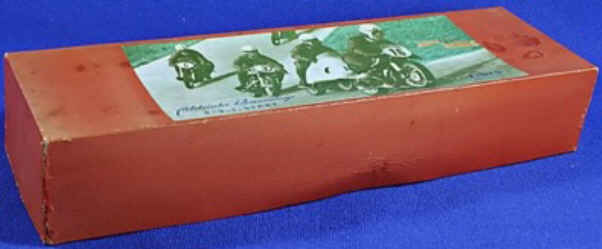
Fibro version of the game
Instead, the Sel-Mac picture, although showing the same scene, is a painting. Obviously the original photograph had been reworked and coloured by hand, to make the picture more colourful and attractive. Bright colours on the helmets and a red stripe on the aero cover of the second bike had been added and even the leather suits appear in different shades of brown and grey.
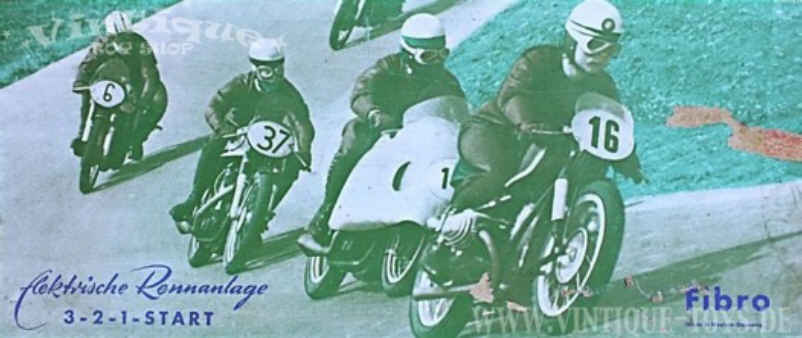
(Picture taken from the invaluable -and sadly
defunct. vintique-toys.de website)
Unfortunately in this transformation some details of the photograph got lost, for example the joint of the pushed swing rod on the front of bike no. 16., the design of frame tubes and exhaust pipes on no. 16, 1?. and 37, some folds in the leather cloth and stripes or shades on the helmets, and the wind shield size on motorcycle no. 6 increased to unusual dimensions. Chronologically the photograph must have been the earlier version, the painting based in the photograph must be the later version. Thus the German game for sure is older.
As this is a real picture, maybe one could find out by an intense research, in which race the picture had been taken. As there had been an uncountable number of motorcycle races in the 1950s and as unfortunately there isn't such a detailled documentation on motorcycle races as there is on motorcar races, I had no hope to find the race results on the www. We would have to find a 500 cc motorcycle race in which are in the starting grid:
No. 6 Norton Manx 500 (or Matchless 500 cc of 1957)
No. 16 BMW RS 54
No. 1.. Norton Manx 500
No. 37 Norton Manx 500Believe it or not, without any intense research, but only a fortunate coincidence, I found just that race, in which this picture actually had been taken! Intendedly I was searching for images of Norton racing machines with an aero cover, to identify the second motorcycle. I don't know, what were the exact search words and why I entered the year 1956, but among the hits on the first page was this PDF:
It is the programme of the 1956 Solitude race, which took place near Stuttgart on July 22nd. Strangely enough I know both well – the Automobile-Club Munich, who put the PDF on the www, and also the Solitude course. But I did not think of that race until it appeared in this search result.
The Solitude was not a permanent race track; it's an official regional road that still exists today almost unchanged. For the race two of the four lanes of the nearby Autobahn were closed and used as parking space for the huge number of spectators ("P5" on page 32 in the programme). Sometimes there were 400.000 spectators! The last race on the Solitude circuit was in 1965. As Stuttgart isn't far away, in the early 1990s I visited the remains of the race track and the pit lane buildings. And in 2003 I saw the great Giacomo Agostini and other famous riders in a revival race, celebrating Solitude's 100th anniversary.Because of my own past history this PDF of the Solitude 1956 programme was my first choice. And actually on page 39 I found the information I was looking for:
No. 6 Norton, Jacques Collot, France
No. 16 BMW, Peter Knees, Germany
No. 12 / 14 / 17 Norton, Bryen / Brown / Jäger
No. 37 Norton, Bob Coleman, New ZealandIf all research would be so simple and quick, this would save me a lot of time! I guess there is no chance to find another race, in which the three clearly identified numbers would fit so well. Based on this strong evidence, I searched for more pictures of the 1958 Solitude 500 cc race. There are only few, but I actually found a picture that reveals the missing fourth number!
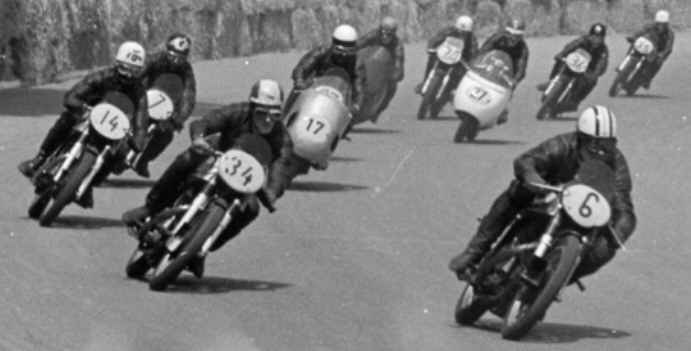
[taken from
http://handmademotorcycle.blogspot.com/2011/12/solitude-22071956.html]
No. 6 Norton, Jacques Collot, France
No. 7 Norton, Edie Grant, South Africa
No. 14 Norton, Keith Bryen, Australia
No. 17 Norton with aero cover!, Hans-Günther Jäger, Germany
No. 24 Matchless, F.R. Cook, New Zealand
No. 27 BMW with aero cover (note the characteristic engine design), Gerold Klinger, Germany
No. 34 Norton, John A. Storr, England
No. 35 Norton, Evert Carlsson, Sweden
No. 36 Matchless, Paul Fahey, New Zealand
No. 16 – BMW, Peter Knees, Germany (not on this picture, but present in the Fibro picture)
No. 37 – Norton, Bob Coleman, New Zealand (not on this picture, but present in the Fibro picture)
Note: The complete picture is an impressive scene, it was taken at the first corner, the "Seehaus- Kurve", just after the start of the race. Strangely this picture appeared on the www for the first time on a website in New Zealand! No. 24 and 36 came from the other side of the globe to Europe for racing, but they are too far behind on this picture fto be a reason to buy it as a souvenir.In this picture, the Norton with aero cover is shown under a different angle, but the design and the air inlets are clearly the same than those in the Fibro picture. Moreover this machine has a double starting number and a second windshield behind the aero cover – which can be seen in the Fibro picture less clearly (that is why in the Sel-Mac painting the starting number and the aero cover were melted). The helmet and scarf of rider no. 17 also are the same.
Now look at the helmet of rider no. 6 – it has the same three (Tricolore) stripes that are shown in the picture of the Fibro game (whereas in the coloured picture of the Sel-Mac game one stripe had been painted over). The Tricolore on the helmet is not only because he was a French rider. Jacques Collot was probably the most famous French motorcycle rider of the 1950s, he was the French 500 cc champion from 1952 to 1955, and again in 1957 and 1958. Collot had a really adventurous life, he was active in the army, the resistance, deep sea diving, speleology (cave research) and archeology. It seems Jacques Collot was the "blue print" for the (male) action dolls that I played with in my childhood days!
The 1956 Solitude race was the German Grand Prix, counting for the world championship. Today the Moto GP competitors keep their number during the whole season, which means there could be another race in which the same riders can be found with the same numbers. But in 1956 there were no such rules, in each race there were different numbers. Geoff Duke, reigning 500 cc world champion, was given no. 3 in the Solitude race of 1956. This race was the only world championship race, in which all four riders of the Fibro picture started together, Peter Knees only raced in Germany.
That many identical details for sure are no coincidence. The chance that those same four riders in the 1950s raced against each other with exactly the same machines, the same numbers and the same outfit in another non-championship race in the 1956 season, or in any other race in any other year, is near to impossible. In reality such things don't happen. As the Solitude race track is only 30 km away from Reichenbach/Fils, the toy maker's site, Fibro used a picture of the famous nearby Solitude race much more likely than one of any other race.
Another clue is given by the leading rider: Peter Knees on his BMW RS 54 was a privateer since BMW closed down their racing department in 1954. In 1956, except the Solitude race, Knees was racing only in the national championship (and races of lower level). At the Solitude he finished 13th, just behind Hans-Günther Jäger (No. 17). Jacques Collot (No. 6, forth in the Fibro picture) overtook both and finished 10th. Bob Coleman (No. 37, third in the Fibro picture) didn't finish.Why was Knees, finishing only in 13th position, given the most prominent position in the Fibro picture? The answer is simple: The final positions didn't matter. Peter Knees was the "local hero", at home in Nagold, only 35 km away from the race track and 55 km away from Reichenbach/Fils. Because of this I'm sure, this picture wasn't chosen randomly: Fibro chose an image with their local hero in front, presumably a try to push the sales in their regional Württemberg market.
The Fibro picture probably was taken at the second Büsnau corner, which is the only tight left-hand bend without road conjunction (some day I will go there again and check it). As Fibro was a Swabian company, maybe the picture was taken by an employee or friend of Fibro, maybe even by the boss himself. That would have reduced the costs for a small company (the Swabians are said to be thrifty, they're rumoured to be the "Scots of Germany").
The picture of course can help us to date the game: It can't be from before August 1956 (more probably it's from the end of 1956). As the German Grand Prix in the following years took place at Hockenheim (1957, 1959) and at the Nürburgring (1958), before it returned to the Solitude race track in 1960, the game could have been published in later years. But it should have been before 1958, the presumed year in which the Fibro plant in Reichenbach/Fils may had closed.
There is a chance that the game could be even older and in its first version had a different picture, which woul later have been replaced after the Solitude race in 1956 to give the box a more eye-catching look. But as long as there is no proof for this, it's remains just a possibility.Although there is no proof for a Fibro version with the coloured painting, I'd assume, there must have been such a German version too – because in the Spanish game the title is "Elektrische Rennanlage". If the coloured painting had been made exclusively for Sel-Mac, they probably would have changed the name of the game. Therefore I would assume, the game was licenced to Sel-Mac after the German version already had changed to the coloured painting (as long as we don't find a Sel-Mac version with a photograph on the box).
In 1956 there were also car races on the Solitude track. Porsche used the new 1500 RS model, with which Umberto Maglioli had won the famous Targa Florio race in Sicily only a few week earlier. In the Solitude race, the three 1500 RS were driven by famous racing drivers: Hans Herrmann and Richard von Frankenberg (both at home in Stuttgart), plus Wolfgang Graf Berghe von Trips (who in 1961 on Ferrari became Formula one champion posthumously). Local hero Hans Herrmann won the race, Trips finished second, Falkenberg fourth. It was a triumph for the Stuttgart company. Why didn't Fibro chose a picture of the sports car race? Maybe at Fibro they all were enthusiastic motorcycle fans? But if this really was the case, it's remains weird, just in the other way: Why are there no motorcycles in this game then, only cyclists?Of course, I also have a theory that would explain this contradiction: The game with the Solitude photograph must have had a predecessor (I already mentioned this possibility above). In the initial version Fibro decided to use only cyclists, cars and horses, no motorcycles. The picture of the initial version probably showed cars. But which cars could that have been?
When I saw the extremely long motor bonnet of the cars in "3-2-1-Start", at first I tought of the Veritas RS, which was the most successful sports car in early German post-war racing. From the first races in 1948 until 1952 all German sport car champions in the 2000 cc class drove Veritas. The Veritas RS is lacking the swing in the side line, though – and it's a two-seater.

The Veritas RS is a racing machine with road approval, it mainly is based on the pre-war BMW 328 and reused many BMW parts, the production place was in Baden-Württemberg (but moved several times). 20 years ago I enjoyed the pleasure of having been offered a ride in a Veritas RS. It literally was a breathtaking experience. You can't hardly breath at 160 km/h due to the air pressure (we didn't go faster because it was an Austrian country road). You can't drive this car without wearing goggles, and if you wear no helmet, you should go to the hair dresser after such a wild ride rather than before.The cars in the German game are painted slighly better and show more details. The Borgward RS (see next page) has the same characteristic three air outlets, though the rest of the design appears too flat and the driver's position is too far in the front. These 1500 cc two-seater cars, made in Bremen, North Germany, were used (without much success) on race tracks from 1953 to 1955.

The most obvious choice of course would have been a Mercedes-Benz, as Stuttgart-Untertürkheim is less than 30 km away from the Fibro site. The famous 300 SLR (left) has different air outlets, but a long motor bonnet and a swing in the side line, but it came late, in May 1955. The Formula one W196 "streamline" of 1954 (right) for my taste would match the Fibro car better – moreover it's a single seater and this model was popular as a toy in the 1950s, Schuco sold many of those.

Although no real car matches the tiny Fibro cars in all details, they clearly had been inspired by racing cars of the 1950s. If Fibro in "3-2-1-Start" wanted to feature real contemporary cars (as they did in other games by featuring Mercedes-Benz and Porsche), in 1954 the W196 was the best choice. With a Mercedes in the box picture the lack of detail didn't matter, the game would have sold. Then the presumed first version of the game must have been published before 1955, when Mercedes-Benz shut down their racing department after the terrible accident in the Le Mans 24h race.If the presumed first version of the game had a Mercedes car on the box and if Fibro had to ask Mercedes-Benz for permission to use that picture, Mercedes' retreat from Motorsport could have been the reason for replacing the picture! A picture of Porsche cars would have been no good choice, as the Porsche design was completely different to the cars in the game. Replacing the cars by Porsche style cars would have required new moulds. If there was such a dilemma in 1956, Fibro could have chosen a motorcycle picture to replace the presumed Mercedes picture. There would have been no need to replace the cars in the game, as they don't show unique Mercedes features. A Veritas picture would have been possible, but the car was already outdated. Racing horses or cyclists probably appeared outdated as well. Adding motorcycle riders to the game would have meant new moulds. So Fibro might have chosen just to change the picture on the box, not the contents of the game, although this seems weird from today's point of view. But maybe in 1956 the kids were expected to imagine the cyclists to be motorcycle riders (remember "Vem far med?"...). And in those days there still existed kits to upgrade bicycles into motorcycles.
Of course in my thesis there is speculation and I can give no proof for it, other than: To me it would be the most logical reason why there aren't motorcycles in this game (though reality isn't always logical). The easiest solution, of course, would be to consider it just a weird decision.
Summary: What do we know now about this game?
• The game was produced by Sel-Mac in Spain, Polyjeux in France and Fibro in Germany.
• The picture on the boxes of the German and Spanish games shows a scene in a German motorcycle race on July 22, 1956. The race took place only 30 km away from Fibro's site. The leading rider is the local hero of this Swabian region. Thus it's originally a Fibro picture.
• The Fibro version should be older than the Sel-Mac version, because the Fibro version has a photograph on its box, whereas the Sel-Mac version has a painting, based on this photograph.
• Fibro had five basically different games with a vibration mechanism. Sel-Mac only produced two simpler versions of those five games, so Sel-Mac probably copied the Fibro game (by license).
• Because the Spanish game has a German title, there also should be a German version with a coloured painting (although up to now there is no proof for this).
• Because there are motorcycles only in the picture but not in the game, there might be an older version with a Mercedes racing car on the box (although up to now there is no proof for this).
Conclusion"3-2-1-Start" originally is a German game, made by Fibro, at home in Reichenbach/ Fils, south-east of Stuttgart. The version with the motorcycle picture was first published by Fibro, most probably in late 1956. But there is reason to believe, a first version with a Mercedes picture could have been released already in 1954.
Impressive work (to say the least) !!!
Thanks Siegfried for sharing your investigation.
Description rewritten in June 2025.
|
CULTURE |
TOTUM REVOLUTUM |
NAMES |
CATEGORIES |
WHAT'S NEW |